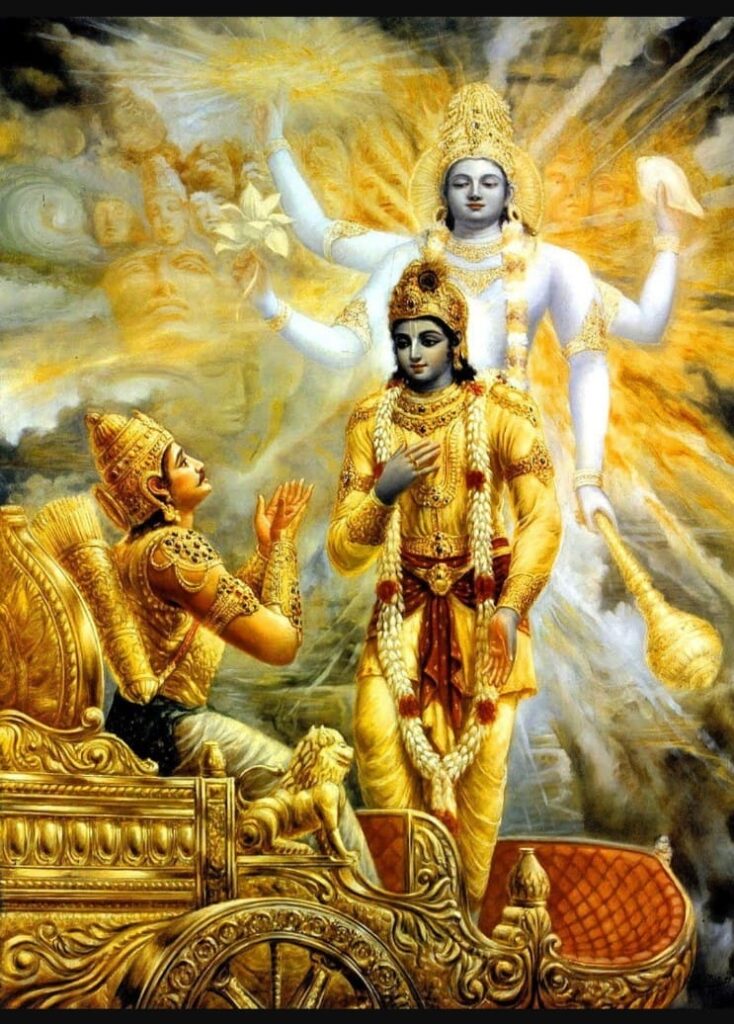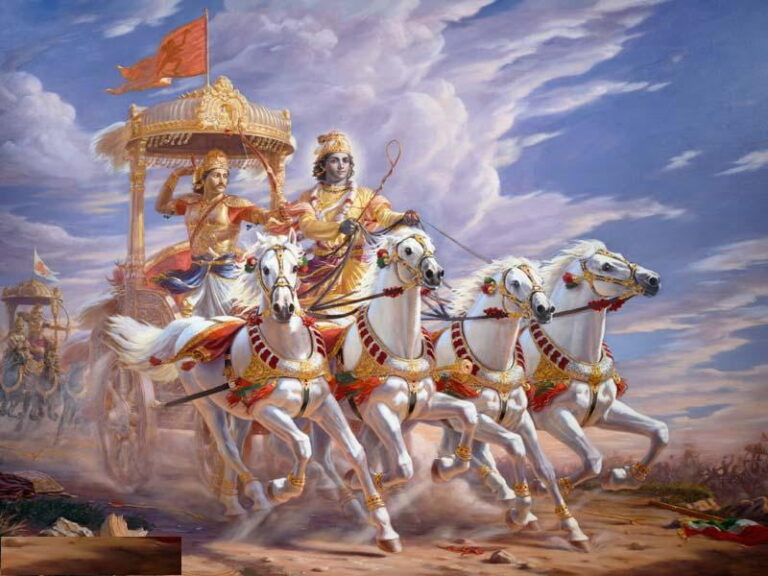Introduction
The Bhagavad Gita, often referred to as the Gita, is a 700-verse Hindu scripture that is part of the Indian epic Mahabharata. It consists of a conversation between Prince Arjuna and the god Krishna, who serves as his charioteer. The Bhagavad Gita covers a wide range of philosophical and spiritual topics, providing guidance on how to live a meaningful and fulfilling life. In this article, we will explore the 7 most important Teachings of the Bhagavad Gita, each carrying profound wisdom and life lessons.
The Essence of the Teachings of the Bhagavad Gita
What Teachings of the Bhagavad Gita are there in Verse 2.47: Duty Without Attachment
कर्मण्येवाधिकारस्ते मा फलेषु कदाचन।
मा कर्मफलहेतुर्भूर्मा ते सङ्गोऽस्त्वकर्मणि ॥47॥
Karmaṇy-evādhikāras te mā phaleṣhu kadāchana
Mā karmaphalaheturbhūrmā te saṅgo ‘stvakarmaṇi ॥47॥
Karmaṇy= in prescribed duties; eva= certainly; adhikārah= right; te= of you; mā= never;
phaleṣhu= in the fruits kadāchana= at any time; Mā= never; karmaphala= in the result of the work; hetuh= cause; bhūh= become mā=never; te= of you; saṅgah= attachment; astu= there should be; akarmaṇi= in not doing prescribed duties.
Translation:
“You have a right to perform your prescribed duties, but you are not entitled to the fruits of your actions.”
This verse emphasizes the importance of detachment from outcomes and encourages selfless action. It teaches us to focus on our responsibilities without being overly concerned about the results.
This is a highly renowned verse from the Bhagavad Gita, and it is well-known to most students in Indian universities. It provides insight into performing actions selflessly, and it is often discussed in the context of Karma Yoga.

In this verse, four teachings related to Karma Yoga are given:
- Perform your duties but do not worry about the results.
- The fruits of your actions are not for your own pleasure, meaning you are not the enjoyer of the results of your actions.
- Avoid being egoistic while performing actions.
- Do not develop attachment to inaction.
These Teachings of the Bhagavad Gita emphasize the importance of selfless action and detachment from the outcomes of our actions, which are fundamental principles of Karma Yoga.
Do your duty, but don’t worry about the results:
We possess the freedom to take action, yet the final outcome doesn’t solely hinge on our efforts. Determining or guaranteeing results involves a multitude of factors, including our exertions, our past deeds (fate), divine will, the contributions of others, the combined efforts of interconnected individuals, and circumstantial factors, among others. Nevertheless, when we fixate on outcomes that deviate from our desires, it tends to generate anxiety.
Therefore, Lord Krishna counsels Arjuna to prioritize the performance of virtuous deeds over preoccupying himself with the consequences. In reality, when we detach ourselves from the results, we can channel our focus more effectively into our efforts, often yielding outcomes that surpass our expectations.
Such are the teachings of the Bhagavad Gita, ain’t they enlightening? Continue reading to delve deeper into its profound wisdom.
What Teachings of the Bhagavad Gita are there in Verse 4.7 : The Divine Incarnation and Its Purpose
यदा यदा हि धर्मस्य ग्लानिर्भवति भारत |
अभ्युत्थानमधर्मस्य तदात्मानं सृजाम्यहम् || 7||
yadā yadā hi dharmasya glānir bhavati bhārata
abhyutthānam adharmasya tadātmānaṁ sṛjāmy aham || 7||
yadā yadā—whenever; hi—certainly; dharmasya—of righteousness; glāniḥ—decline; bhavati—is; bhārata—Arjun, descendant of Bharat; abhyutthānam—increase; adharmasya—of unrighteousness; tadā—at that time; ātmānam—self; sṛijāmi—manifest; aham—I
Translation: “Whenever there is a decline in righteousness and an increase in unrighteousness, O Arjuna, at that time I manifest myself on earth.”
Krishna’s declaration in this verse underscores the idea that divine intervention occurs when the world is in moral crisis. It reassures us that higher powers are always at work to restore balance.
Dharma fundamentally represents the ordained actions that foster our spiritual evolution and advancement; conversely, adharma signifies unrighteousness. In times when unrighteousness prevails, the architect and overseer of the cosmos intervenes through a divine descent to restore dharma. This divine descent of the Supreme Being is known as an Avatār.
The term “Avatar” finds its origins in Sanskrit and is commonly associated with digital representations of individuals in modern media. In this discourse, we shall employ its authentic Sanskrit essence, referring to the divine manifestation of the Supreme. The Śhrīmad Bhāgavatam enumerates a total of twenty-four such divine descents.
These Avatars fall into four distinct categories, know about them here. Avatars
These Teachings of the Bhagavad Gita imparts profound wisdom on various aspects of life, spirituality, and the divine.
What Teachings of the Bhagavad Gita are there in Verse 6.5: Control Over the Mind
उद्धरेदात्मनात्मानं नात्मानमवसादयेत् |
आत्मैव ह्यात्मनो बन्धुरात्मैव रिपुरात्मन: || 5||
uddhared ātmanātmānaṁ nātmānam avasādayet
ātmaiva hyātmano bandhur ātmaiva ripur ātmanaḥ
uddharet—elevate; ātmanā—through the mind; ātmānam—the self; na—not; ātmānam—the self; avasādayet—degrade; ātmā—the mind; eva—certainly; hi—indeed; ātmanaḥ—of the self; bandhuḥ—friend; ātmā—the mind; eva—certainly; ripuḥ—enemy; ātmanaḥ—of the self

“A person can rise through the efforts of his own mind;; and; draw; his own; downfall, in the same manner. Because each person is his own friend or enemy in either the face of adversity or opportunity.”
We hold the responsibility for our own ascent or descent. The journey towards God-realization is a path we must tread individually; no one can undertake it on our behalf. Saints and Gurus illuminate the way for us, but we must undertake the journey ourselves.
This Teachings of the Bhagavad Gita highlights the pivotal role of our thoughts and intentions in shaping our destiny. It encourages us to be mindful of our inner choices.
What Teachings of the Bhagavad Gita are there in Verse 18.66: Surrender to the Supreme
सर्वधर्मान्परित्यज्य मामेकं शरणं व्रज |
अहं त्वां सर्वपापेभ्यो मोक्षयिष्यामि मा शुच: || 66||
sarva-dharmān parityajya mām ekaṁ śharaṇaṁ vraja
ahaṁ tvāṁ sarva-pāpebhyo mokṣhayiṣhyāmi mā śhuchaḥ
sarva-dharmān — all varieties of religion; parityajya — abandoning; mām — unto Me; ekam — only; śaraṇam — for surrender; vraja — go; aham — I; tvām — you; sarva — all; pāpebhyaḥ — from sinful reactions; mokṣayiṣyāmi — will deliver; mā — do not; śucaḥ — worry.
“Abandon all varieties of religion and just surrender unto Me. I shall deliver you from all sinful reactions. Do not fear.”
In the final verse of the Bhagavad Gita, in this Krishna invites us to transcend religious dogma and surrender to the universal divine. It signifies the path of ultimate liberation through devotion.
All along, Shree Krishna had been asking Arjun to do two things simultaneously—engage his mind in devotion, and engage his body in fulfilling his material duty as a warrior. He thus wanted Arjun not to give up his Kshatriya dharma, but to do devotion alongside with it. This is the principle of karm yog.
Now, Shree Krishna reverses this teaching by saying that here is no need to fulfill even material dharma. Arjun can renounce all material duties and simply surrender to God. This is the principle of karm sanyās. Here, one may question that if we give up all our material dharmas will we not incur sin? Shree Krishna tells Arjun not to fear; he will absolve him from all sins, and liberate him from material existence.
The Power of Self-Realization : Teachings of the Bhagavad Gita
What Teachings of the Bhagavad Gita are there in Verse 4.8: The Nature of the Divine Incarnation
परित्राणाय साधूनां विनाशाय च दुष्कृताम् |
धर्मसंस्थापनार्थाय सम्भवामि युगे युगे || 8||
paritrāṇāya sādhūnāṁ vināśhāya cha duṣhkṛitām
dharma-sansthāpanārthāya sambhavāmi yuge yuge
paritrāṇāya—to protect; sādhūnām—the righteous; vināśhāya—to annihilate; cha—and; duṣhkṛitām—the wicked; dharma—the eternal religion; sansthāpana-arthāya—to reestablish; sambhavāmi—I appear; yuge yuge—age after age
“In order to deliver the pious and to annihilate the miscreants, as well as to reestablish the principles of religion, I advent Myself millennium after millennium.”
Having previously mentioned that God descends into the world, the text now outlines three purposes for this divine descent: 1) To annihilate the wicked. 2) To protect the Righteous. 3) To establish Dharma. However, upon closer examination, these three rationales may not appear entirely convincing:
- To protect the righteous: God resides within the hearts of his devotees, perpetually safeguarding them from within. Thus, there seems to be no necessity for an Avatar to fulfill this purpose.
- To annihilate the wicked: God possesses omnipotent authority and can extinguish wickedness merely by willing it. Therefore, the question arises as to why an Avatar is required to achieve this goal.
- To establish Dharma: Dharma is perpetually expounded in the Vedas, and God can reestablish it through a Saint; there may not be a need for his personal descent to accomplish this objective.
This Teachings of the Bhagavad Gita reaffirms the cyclical nature of divine incarnations and their purpose in maintaining righteousness in the world.
Unlock the profound Teachings of the Bhagavad Gita by acquiring your personal copy now, and embark on a journey of self-discovery and enlightenment. – Order Today.
What Teachings of the Bhagavad Gita are there in Verse 6.6: Controlling the Mind through Steadiness
बन्धुरात्मात्मनस्तस्य येनात्मैवात्मना जित: |
अनात्मनस्तु शत्रुत्वे वर्ते तात्मैव शत्रुवत् || 6||
bandhur ātmātmanas tasya yenātmaivātmanā jitaḥ
anātmanas tu śhatrutve vartetātmaiva śhatru-vat
bandhuḥ—friend; ātmā—the mind; ātmanaḥ—for the person; tasya—of him; yena—by whom; ātmā—the mind; eva—certainly; ātmanā—for the person; jitaḥ—conquered; anātmanaḥ—of those with unconquered mind; tu—but; śhatrutve—for an enemy; varteta—remains; ātmā—the mind; eva—as; śhatru-vat—like an enemy
“For him who has conquered the mind, the mind is the best of friends; but for one who has failed to do so, his mind will remain the greatest enemy.”
A significant portion of our mental faculties and energy often gets consumed in combating individuals we perceive as adversaries, those who might pose a threat to us. According to Vedic scriptures, our most formidable adversaries—such as lust, anger, greed, envy, and illusion—reside within our own minds. These internal foes are even more insidious than external ones.
While external adversaries may inflict temporary harm, the demons lurking within our minds possess the capacity to subject us to perpetual misery. We’ve witnessed individuals who, despite having all external circumstances in their favor, lead wretched lives because their own minds incessantly torment them with feelings of depression, hatred, tension, anxiety, and stress.
Here, the Gita teaches us that mastery over our own mind is the key to inner peace and self-realization.
The Path of Devotion: Teachings of the Bhagavad Gita
What Teachings of the Bhagavad Gita are there in Verse 9.22: Devotion and the Supreme Divine
अनन्याश्चिन्तयन्तो मां ये जना: पर्युपासते |
तेषां नित्याभियुक्तानां योगक्षेमं वहाम्यहम् || 22||
ananyāśh chintayanto māṁ ye janāḥ paryupāsate
teṣhāṁ nityābhiyuktānāṁ yoga-kṣhemaṁ vahāmyaham
ananyāḥ—always; chintayantaḥ—think of; mām—Me; ye—those who; janāḥ—persons; paryupāsate—worship exclusively; teṣhām—of them; nitya abhiyuktānām—who are always absorbed; yoga—supply spiritual assets; kṣhemam—protect spiritual assets; vahāmi—carry; aham—I
“To those who are constantly devoted and who meditate upon Me with love, I am easy to obtain because of their constant engagement in devotional service.”
A mother never contemplates abandoning her helpless newborn child, one entirely reliant on her care. The supreme and eternal mother of the soul is God. In this verse, God imparts a maternal reassurance to those souls who wholeheartedly surrender to Him.
The phrase used, “vahāmi aham,” signifies “I personally bear the responsibility of sustaining My devotees,” much like a married man shoulders the responsibility of providing for his wife and children. God pledges two significant assurances: firstly, “yog,” wherein He bestows upon His devotees spiritual assets they may lack, and secondly, “kṣhem,” signifying the protection of the spiritual assets already possessed by His devotees.
This verse highlights the significance of unwavering devotion as a means to connect with the divine.
Conclusion
The Bhagavad Gita offers profound insights into life, duty, and spirituality. These 7 Shlokas represent the essence of Teachings of the Bhagavad Gita, providing guidance on how to live a purposeful and virtuous life. By embracing the wisdom contained within these verses, we can navigate the complexities of existence with grace and resilience.
Discover the timeless wisdom of the Bhagavad Gita – get your own copy today and embark on a transformative journey. Order Here…
Frequently Asked Questions (FAQs):
What is the Bhagavad Gita?
Why are these 7 Shlokas considered important?
How can I apply the teachings of the Bhagavad Gita in my daily life?
Is the Bhagavad Gita only for Hindus?
Where can I access the complete Bhagavad Gita?
You check out few here… https://amzn.to/3Zhfnr5






[…] 2 […]